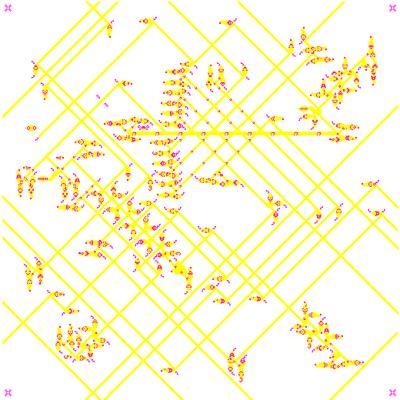http://golly.sourceforge.net
I think the Life-logic circuitry can be simplified considerably if the neighbor-count chute is modified a bit; in particular, if the stream of gliders that reads the contents of the chute is slowed down to (let's say) p64, then it's possible to check that either the #2 or the #3 neighbor-count glider is the first one out of the chute -- and then suppress the #2 neighbor-count glider with a negated cell-is-ON signal.

With a long-enough gap between gliders, Herschel-based switches can allow just the first glider of a stream to get through, then automatically reset itself afterwards. Here's one such circuit that works at p64:
Okay, now imagine a Unit Life Cell with no moving parts. An infinite grid of OFF unitcells will just sit there; it takes three appropriately-timed gliders from neighboring unitcells to activate a given cell, and then it stays activated only as long as two or three gliders keep coming in to sustain it.
A glider at some critical spot still means the unitcell is ON, and the lack of that glider means that it's OFF.
As in the p8 case, the fanout device is simple to construct with Herschel circuitry -- it could be a standard G->H converter (fairly compact at p8, but not too bad even at p1) followed by a string of glider-producing conduits:
Then the trouble starts. If the unitcell can't have any moving parts, there can't be a "timing gun" in it saying when to look for gliders from neighboring cells. So we have to always produce a "timing" signal at exactly the same time no matter which gliders come in from neighboring cells -- one glider, two gliders, eight gliders.

I have the feeling that I'm not being clever enough, but the best design I can think of at the moment is a string of eight circuits like the following sample pattern, each hooked up to an input glider from a neighboring cell:
Then you also have to actually count the number of signals from neighboring cells. Luckily the above pattern has a spare output glider for each input signal, and these could be collected into a single lane with standard stable reflectors and sent through a counting mechanism. Here's one possibility:
#C ladder from programmable constructor --
#C could be used as a configurable neighbor-counting mechanism
x = 424, y = 465, rule = B3/S23
207bo$207b3o$210bo$191bo17boo$179bo11b3o$177b3o14bo$161bo14bo16boo$
161b3o12boo$164bo$163boo3$164boo$164boo17boo$183boo$$221boo$221boo3$
180boo$180bo19boo$181b3o15bobo$183bo15bo$177boo19boo$177bo$178b3o$180b
o6$186boo$186bo$167boo15bobo$167boo15boo$155boo$154bobo$154bo$153boo$
47bo9bo$47b3o5b3o27bo$37boo11bo3bo30b3o$16bo19bobo10boo3boo32bo14bo$
17bo18bo50boo12b3o$15b3o17boo63bo$100boo$166boo$165bobo$99boo64bo$80b
oo17boo63boo$32boo46boo$bboo28boo$3bo$3o$o$$83boo$63boo19bo$43bo6boo
11bobo15b3o92boo$41b3o6boo13bo15bo94boo$40bo24boo19boo$40boo45bo$84b3o
$84bo$$165boo107bo$166bo19boo86b3o$102boo62bobo17bo90bo$78bo23bobo62b
oo15bobo71bo17boo$78b3o23bo74bo4boo60bo11b3o$81bo22boo72bobo63b3o14bo$
80boo14boo80bobo47bo14bo16boo$96boo69boo10bo48b3o12boo$166bobo62bo$
166bo63boo$165boo$180boo$180bo50boo$181b3o47boo17boo$183bo66boo$$288b
oo$288boo$$97boo$97bobo147boo$99bo147bo19boo$99boo147b3o15bobo$250bo
15bo$244boo19boo$244bo$245b3o$247bo4$87boo$87boo$253boo$253bo$96boo
136boo15bobo$96boo136boo15boo$222boo$221bobo$221bo$220boo$95boo17bo9bo
$95bo18b3o5b3o27bo$91boo3b3o5boo11bo3bo30b3o$91bobo4bo4bobo10boo3boo
32bo14bo$93bo9bo50boo12b3o$62boo29boo7boo63bo$61bobo103boo$61bo4boo
165boo$60boo5bo164bobo$64b3o99boo64bo$64bo82boo17boo63boo$99boo46boo$
69boo28boo$70bo$67b3o$67bo$$150boo$130boo19bo$110bo6boo11bobo15b3o92b
oo$108b3o6boo13bo15bo94boo$107bo24boo19boo$107boo45bo$151b3o$151bo$$
232boo$233bo19boo90boo$169boo62bobo17bo91boo$145bo23bobo62boo15bobo71b
o$145b3o23bo74bo4boo60bo11b3o$148bo22boo72bobo63b3o14bo$147boo14boo80b
obo47bo14bo16boo$163boo69boo10bo48b3o12boo$233bobo62bo$233bo63boo$232b
oo$247boo$247bo50boo$248b3o47boo17boo$250bo66boo$$355boo$355boo$$164b
oo$164bobo147boo$166bo147bo19boo$166boo147b3o15bobo$317bo15bo$311boo
19boo$311bo$312b3o$314bo4$154boo$154boo$320boo$320bo$163boo136boo15bob
o$163boo136boo15boo$289boo$288bobo$288bo$287boo$162boo17bo9bo$162bo18b
3o5b3o27bo$158boo3b3o5boo11bo3bo30b3o$158bobo4bo4bobo10boo3boo32bo14bo
$160bo9bo50boo12b3o$129boo29boo7boo63bo$128bobo103boo$128bo4boo165boo$
127boo5bo164bobo$131b3o99boo64bo$131bo82boo17boo63boo$166boo46boo$136b
oo28boo$137bo$134b3o$134bo$$217boo$197boo19bo$177bo6boo11bobo15b3o92b
oo$175b3o6boo13bo15bo94boo$174bo24boo19boo$174boo45bo$218b3o$218bo$$
299boo107bo$300bo19boo86b3o$236boo62bobo17bo90bo$212bo23bobo62boo15bob
o71bo17boo$212b3o23bo74bo4boo60bo11b3o$215bo22boo72bobo63b3o14bo$214b
oo14boo80bobo47bo14bo16boo$230boo69boo10bo48b3o12boo$300bobo62bo$300bo
63boo$299boo$314boo$314bo50boo$315b3o47boo17boo$317bo66boo$$422boo$
422boo$$231boo$231bobo147boo$233bo147bo19boo$233boo147b3o15bobo$384bo
15bo$378boo19boo$378bo$379b3o$381bo4$221boo$221boo$387boo$387bo$230boo
136boo15bobo$230boo136boo15boo$356boo$355bobo$355bo$354boo$229boo17bo
9bo$229bo18b3o5b3o27bo$225boo3b3o5boo11bo3bo30b3o$225bobo4bo4bobo10boo
3boo32bo14bo$227bo9bo50boo12b3o$196boo29boo7boo63bo$195bobo103boo$195b
o4boo165boo$194boo5bo164bobo$198b3o99boo64bo$198bo82boo17boo63boo$233b
oo46boo$203boo28boo$204bo$201b3o$201bo$$284boo$264boo19bo$244bo6boo11b
obo15b3o92boo$242b3o6boo13bo15bo94boo$241bo24boo19boo$241boo45bo$285b
3o$285bo$$366boo$367bo19boo$303boo62bobo17bo$279bo23bobo62boo15bobo$
279b3o23bo74bo4boo$282bo22boo72bobo$281boo14boo80bobo$297boo69boo10bo$
367bobo$367bo$366boo$381boo$381bo$382b3o$384bo5$298boo$298bobo$300bo$
300boo9$288boo$288boo3$297boo$297boo5$296boo17bo9bo$296bo18b3o5b3o27bo
$292boo3b3o5boo11bo3bo30b3o$292bobo4bo4bobo10boo3boo32bo14bo$294bo9bo
50boo12b3o$263boo29boo7boo63bo$262bobo103boo$262bo4boo$261boo5bo$265b
3o99boo$265bo82boo17boo$300boo46boo$270boo28boo$271bo$268b3o$268bo$$
351boo$331boo19bo$311bo6boo11bobo15b3o$309b3o6boo13bo15bo$308bo24boo
19boo$308boo45bo$352b3o$352bo4$370boo$346bo23bobo$346b3o23bo$349bo22b
oo$348boo14boo$364boo12$365boo$365bobo$367bo$367boo9$355boo$355boo3$
364boo$364boo5$363boo$363bo$359boo3b3o$359bobo4bo$361bo$330boo29boo$
329bobo$329bo4boo$287bo40boo5bo$285b3o44b3o$284bo47bo25boo$284boo53boo
17bobo$269boo67bobo19bo$270bo67bo21boo$270bobo6bo57boo$271boo4bobo3bo$
278boobbobo$282bobo$283bo4boo$271boo15bobo$270bobo17bo65boo$270bo19boo
64bo$269boo86b3o$359bo$294boo$294bo$292bobo$292boo46boo$280boo57bobo$
280boo57bo$338boo7$348boo$268boo78boo$269bo$269bobo83bo$270boo83b3o$
358bo$357boo$337boo$338bo$338bobo$339boo3$353boo$353bobo$355bo$271boo
15boo65boo$271boo15bobo$263boo25bo$264bo25boo$264bobo$265boo$$350boo$
350bo$284bo66b3o$282b3o68bo$281bo$281boo20bo$287bo15b3o$285b3o18bo$
284bo20boo11boo$284boo32boo6$287boo37boo21boo$268boo17boo36bobo21boo$
268boo55bo17boo$324boo17boo$$267boo$268bo76boo$265b3o12boo56boo5boo$
265bo14bo16boo39boo$281b3o14bo$283bo11b3o20boo$295bo22bo$319b3o$321bo!
Because there's a separate output for each possible neighbor count (if the ladder were extended to eight "rungs") it's possible to add eaters to block off outputs corresponding to any standard Bnnn.../Snnn... rule. The remaining outputs would be collected into a single lane with standard stable reflectors, as before -- the ladder would be set up so that there's at most one output glider for any neighbor-count (and either an ON or OFF cell-state signal, which suppresses either the S or B part of the ladder's output signal.)
The size of the ladder means that 512^2 is probably too small to hold the entire stable pattern -- but the next larger power of two, 1024^2, should be plenty big enough. And it should be relatively easy to adjust the period of the cell to a power of two, as well: probably p8192.

